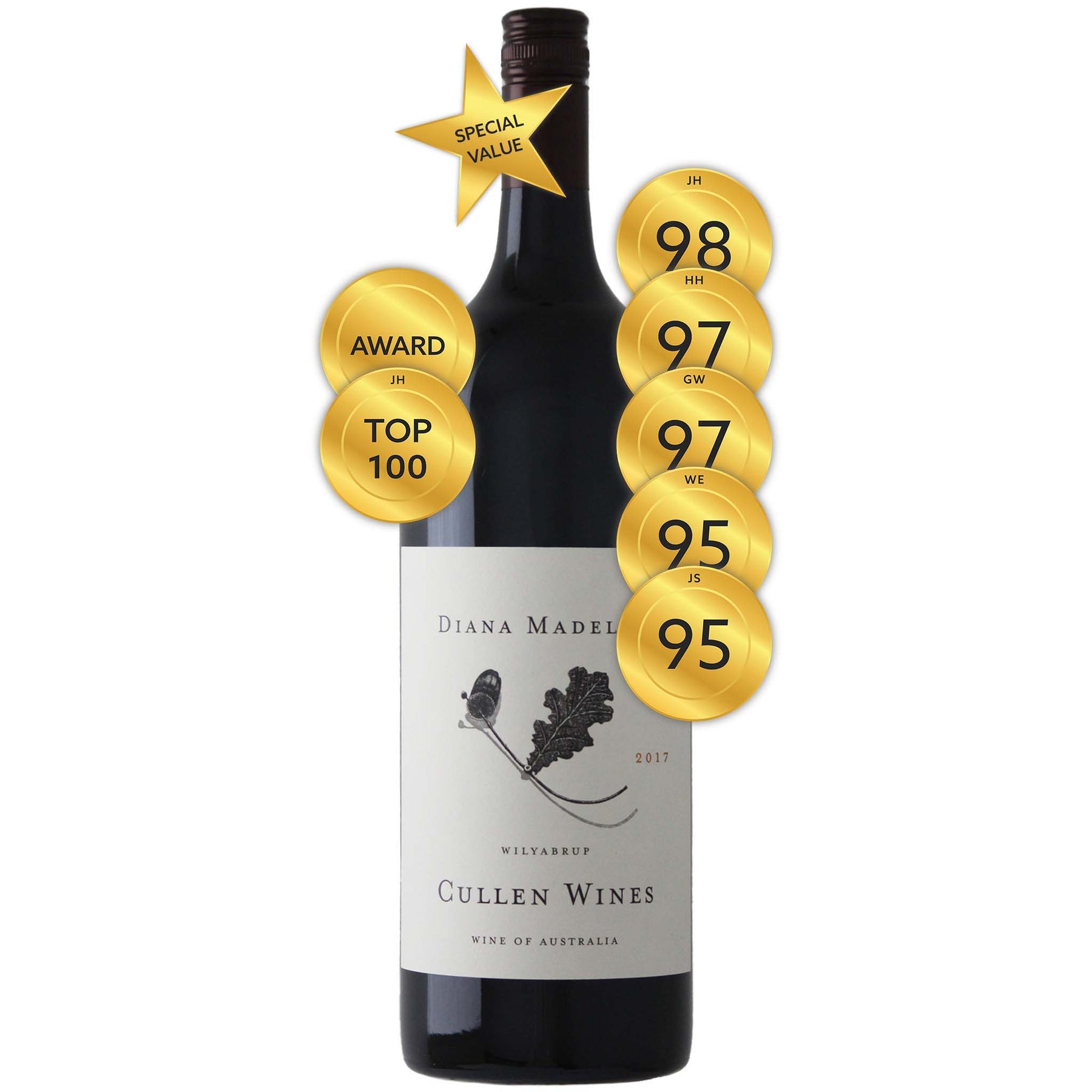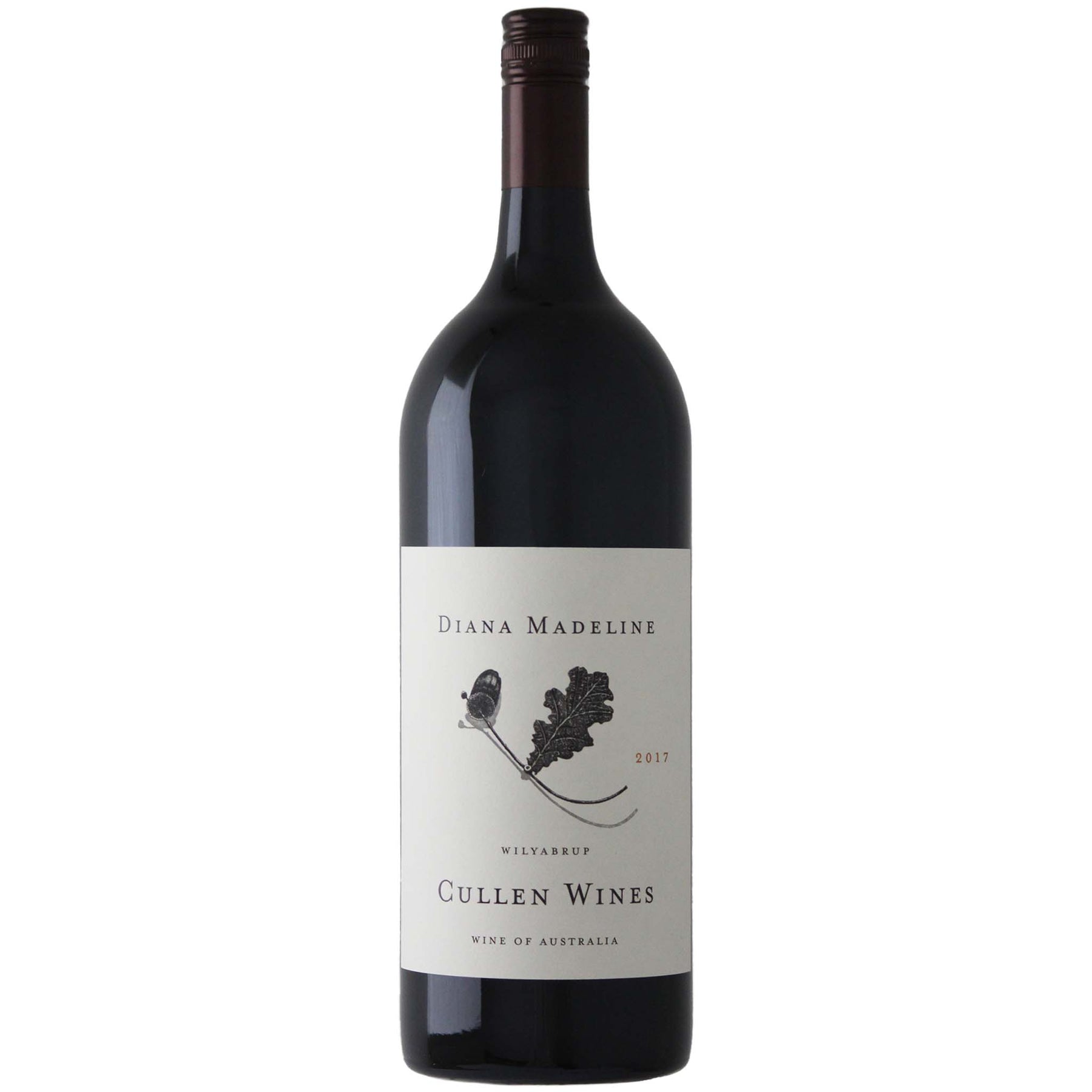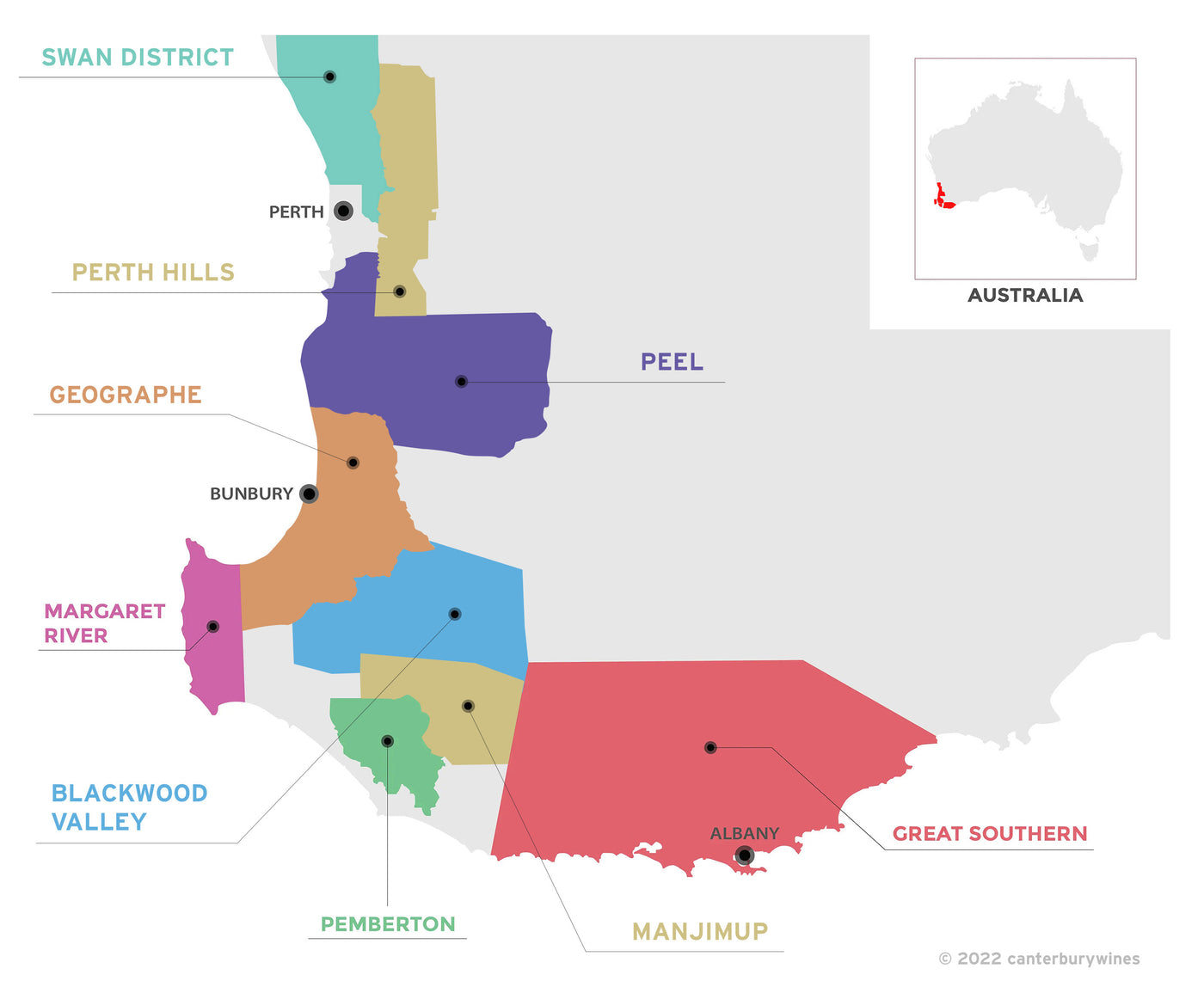

Cullen Diana Madeline 2017 (1500ml)
Style: Red Wine
Closure: Screwcap
Cullen Diana Madeline 2017 (1500ml)
Warehouse
34 Redland Drive
Vermont VIC 3133
Australia
Critic Score: 98
Alcohol: 13.0%
Size: 1500 ml
Drink by: 2070
James Halliday Top 100 Wines of 2019
Halliday Wine Companion Best Cabernet & Family Winner 2020
Cullen is an iconic Margaret River winery and the Diana Madeline is their flagship red wine. It is famed for its quality and consistency, is sought after by collectors world-wide and is a worthy regional benchmark. It is a classic Cabernet Sauvignon dominant Bordeaux blend grown on an exemplary vineyard. The Cullen vineyard has been certified both Organic and Biodynamic since 2004.
"It has waves of complexity, changing shape as the luxuriant cassis swells on the mid-palate, then finishes with ripe, textured tannins. The overall freshness is perfection." James Halliday
"100% Cullen Vineyard. 81% Cabernet Sauvignon, 10% Merlot, 6% Petit Verdot, 3% Malbec. Aged for 18 months in barriques of which 40% were new.
Bright deep purple. on the nose, fantastic complexity and vibrancy with layers of dark fruits complimented by some herbal notes. Elegant and poised: silky palate delivering blueberry, currant notes and some cacao bitterness. Another fantastic vintage for our flagship and to be enjoyed over the next few decades. Cellar: 30 plus years." Cullen
Expert reviews
"A wild-fermented Bordeaux blend matured for 18 months in French oak (40% new). It has waves of complexity, changing shape as the luxuriant cassis swells on the mid-palate, then finishes with ripe, textured tannins. The overall freshness is perfection. Drink by 2042." James Halliday, Halliday Wine Companion - 98 points and Top 100 Wines of 2019 and Special Value Wine ★
"Very deep, bright red/purple colour, youthful and concentrated, the perfumed bouquet showing nutmeg, walnut, savoury and oak-tinged, with discreet violets and berries in the background. The palate is full-bodied but elegantly-styled and tightly-structured, with abundant firm tannins. Intense and focused, it's a little closed at present and needs more time. If you pour it now, give it time in the glass (or decanter), and you'll be rewarded. Drink: 2022–2039." Huon Hooke, The Real Review - 97 points
"Blackberry, blackcurrant, a little nougat oak, and plenty of violet perfume. Medium-bodied, cool and svelte, flows along beautifully, acidity is pitch-perfect, tannin fine but dense and toothsome, and the finish is so very long and composed. Tobacco savouries add complexity. It's a wine of charm and grace, and such wonderful perfume. Drink : 2022 - 2037+." Gary Walsh, The Wine Front - 97 points
"Like all of Cullen's top reds, this Bordeaux-style blend—made from the winery's home block of biodynamically farmed fruit—is still a baby. Its youth is particularly pronounced in a cool vintage like 2017, but with time to open up, it hints at extraordinary things for the future. Whispers of dried rose petal, clove, wild currant, red cherry, seaweed and minerals are tucked into a bed of chocolaty, spicy oak, which will integrate with time. The luscious, high-toned fruit is held together by fine, nervy tannins. Put this far out of reach, and don't touch for at least another five years. Drink 2025–2040." Christina Pickard, Wine Enthusiast – 95 points
"Extremely refined and full of tension with blackberry, currant and licorice character. Hints of wet earth. Medium to full body. Firm and silky tannins. Flavorful finish. From biodynamically grown grapes. Better after 2021. Screw cap." James Suckling, JamesSuckling.com - 95 points
Awards
James Halliday Top 100 Wines of 2019
Halliday Wine Companion Best Cabernet & Family Winner 2020
Special Value Wine – Halliday Wine Companion ★
Organic /biodynamic

The combination of firstly organic, and subsequently biodynamic viticulture at Cullen Wines provides the opportunity for the land to exist at its full potential, thereby nurturing vines to produce their best and most individual grapes. Vanya Cullen has pushed the limits of biodynamic practices in every facet of the business and the yield of the estate vineyards has soared. All Cullen Wines are grown on a certified Biodynamic, Carbon Neutral and naturally powered estate.
Organic Viticulture
Since 1971 when the Cullen Vineyard was planted, chemical intervention was minimal and the family's concern for the environment paramount. In 1998 the change to total organic viticulture was made. Organics is about soil health and Diana and Vanya went intuitively towards healing the soil by putting back what had been taken out. Organic farming promotes biological activity, which converts plant and animal residue into stable humus. This in turn increases the soil's ability to retain moisture and provide a reserve of nutrients. The Cullen vineyards were certified A Grade Organic in 2003.
Biodynamic Viticulture
In 2003, whilst attending a Biodynamic Conference, Vanya Cullen decided that Biodynamics would add further to the holistic and natural approach to both vineyard and winemaking. Biodynamics builds on organic farming to make all organic processes work more efficiently and effectively.
Biodynamic viticulture is a philosophy combining the maintenance of sustainable soil fertility and the recognition of the link between plant growth and the rhythms of the cosmos. Moon rhythms strongly influence life on earth life. As tides rise and fall in a pulsing rhythm, so does the sap of plants and all other liquids including those within the earth's mantle. Viticultural practices are conducted according to these moon rhythms. The position of the moon in relation to the planets is critical in determining the optimal time to plant.
In addition, the difference between organic and biodynamic is the use of biodynamic preparations 500 and 501, with 502-508 also being used. Preparation 500 is cow horns filled with cow manure which helps the soil develop humus and attracts earthworms and micro organisms. Preparation 501 is cow horns filled with quartz crystals which aids photosynthesis and the uptake of minerals in the soil.
In 2004 the Cullen vineyards were certified A Grade Biodynamic.
About the winery

In 1948, Dr Kevin John Cullen and his wife Diana Madeline Cullen purchased their property in Wilyabrup, which is in the heart of Margaret River. In early 1965 they started considering other uses for their sheep and cattle farm. They decided to plant lupins, so invited Dr John Gladstones (who had studied lupins in his post-graduate research) to visit their property. Dr Gladstones had also put considerable work and research into the suitability of growing vines in southwestern Australia and, according to Diana, upon seeing their land said "Oh, you're mad growing cattle and sheep, why don't you grow grapes?"
Dr Gladstones described Wilyabrup as being the sweet spot of the Margaret River region, most favourable for growing Cabernet Sauvignon. In 1966 he published his now-famous report which compared the climate and soils of Margaret River to that of Bordeaux. Many regard him as the founder of the Margaret River wine region.
In 1971 Kevin and Diana Cullen made the decision to plant 18 acres of vines on the land, including their first Cabernet Sauvignon vines. Further plantings were made over the subsequent decades. The mature 28-hectare dry grown vineyard still operates today and the grapes for all the Cullen wines are sourced from here and the adjacent Mangan Vineyard which was planted in 1995.
While Kevin Cullen worked as a doctor to support the business, Diana Cullen supervised and managed the winery and became Chief Winemaker in 1981. Diana made history in 1982 by being the first woman to win a trophy at the Perth Royal Show. Kevin passed away in 1994 and Diana in 2003, and the Cullen flagship wines are now named in their honour; the Kevin John Chardonnay and Diana Madeline Cabernet Sauvignon Merlot. Both Kevin and Diana have been awarded life membership with the Margaret River Wine Industry Association, and in 2003 the WA Wine Industry Association introduced the annual Diana Madeline Cullen Award for Outstanding Contribution by an Individual to the WA Wine Industry in her honour.
In 1983 Diana was joined by daughter Vanya Cullen, who took over the reign as Chief Winemaker in 1989 and was also appointed Managing Director in 1999. With Vanya at the helm, the quality of the wine is paramount and every step taken in the vineyard and in the winemaking is geared to that aim. The quality of Cullen Wines comes in the main from the vineyard - the wines can only be as good as the grapes. To realise the full potential of the vineyard, Vanya has embraced organic and biodynamic viticultural practices and the vineyards were certified A Grade Organic in 2003 and A Grade Biodynamic in 2004.
The process of making the wine involves handling the fruit as little and as gently as possible. Practices such as hand harvesting, minimal fruit transport, sorting of the fruit before crushing, minimal wine movement, minimal fining for the whites, no fining for the reds and minimal filtration are employed. The wines mostly make themselves, with little or no intervention; which means the use of indigenous yeast, no additions of any kind and minimal oak use and fining.
Vanya Cullen received the "Australian Winemaker of the Year" award from Gourmet Traveller Wine magazine in 2000 and was voted "Woman of the Year" by UK based wine magazine The Drinks Business in 2008, becoming the first Australian to receive the award. Vanya was also awarded Halliday Wine Companion's winemaker of the year in 2020.
Cullen became the first vineyard and winery in Australia to be certified carbon positive, starting the process in 2006. Vanya Cullen is also on the board of the "Days of Change" program, which aims to help Western Australian people and businesses live and operate in a more sustainable way.
2021 marked a half-century for the brand and with it a celebration of the Cullen Wines legacy. "This year we celebrate 50 years of Cullen Wines – 50 years of sustainable wine growing preceded by 65,000 years of Wadandi sustainable land care," says Vanya. "Over that time we've been supported by generous people with a wonderful spirit of camaraderie and warmth of spirit, and we are so grateful."


Western Australia
Western Australia is home to more than 400 wineries across nine vast and extraordinary wine regions which are almost entirely concentrated in the south-west and great southern land divisions of the State. The regions are Blackwood Valley, Geographe, Great Southern, Peel, Pemberton, Manjimup, Margaret River and Swan District.
The oldest region is the Swan Valley, the best known both nationally and internationally is Margaret River and the largest is Great Southern. The Great Southern region is further divided into the five subregions of Albany, Denmark, Frankland River, Mount Barker and Porongurup.
The history of wine production in Western Australia dates back to 1840 with the establishment of Sandalford in the Swan Valley region. The recognition of the fine wine possibilities started to be realised after the establishment of the Margaret River Region in 1967, which has become renowned for its high quality Chardonnay and Cabernet Sauvignon. The other regions produce a diverse range of regionally distinct wines, from stunning Rieslings and evocative Shiraz, to a range of unique Cabernet Sauvignon blends.



